

Alamosa Trees: Winter Identification
This page looks at typical Alamosa trees listed by common names in alphabetical order. Some trees have more winter identifying characteristics than others. Please let me know if you have more information.
All photos were taken in Alamosa, January 2012 by Marilyn Loser unless otherwise noted.
Definition of a few terms:
- Alternate twig, bud and leaf structure: Scattered singly along the axis (as opposed to opposite)
- Lateral bud: buds on each side of a branch.
- Leaf scar: Scar of the leaf attachment. When the leaf drops, a scar is left just under the bud.
- Lenticels: openings found in bark that allow gas exchange between the atmosphere and the inner tissues of a plant.
- Opposite twig: bud and leaf structure: Buds grow opposite from one another along twig.
- Pith: soft, spongy tissue inside stem.
- Terminal bud: bud on the tip of every twig. Often larger than the lateral buds.
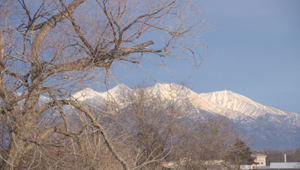
Looking through a Siberian elm at Blanca Peak, January 2012
Ash
- -Opposite structure
- -Tall, pointed lateral buds
- -Terminal buds more cone shaped
- -Buds are black or very dark, looking sooty
- -Pitchfork-like limb tips on many species
- -Leaf scar is shield shaped - looks like a smiley face
- -Twigs often stout and never reddishBark is smooth grey or a pale grey-brown in young trees.
- -In older trees the bark becomes fissured into interwoven ridges which may look diamond shaped
Ash, Oak-leafed
- -Reddish bark with white lenticels
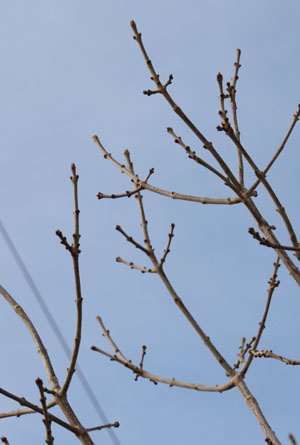
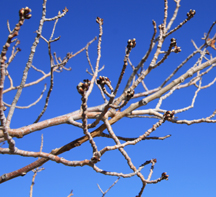
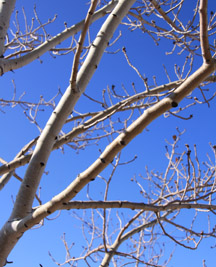
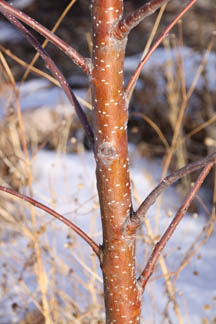
Left: Ash-note opposite branching structure & longer, pointy terminal buds.
Middle Top: Fuzzy Aspen buds.
Middle Bottom: Note black spots along trunk where Aspen shed little branches
Right: Oak-leafed Ash - young tree with reddish trunk and white, raised lenticels
Aspen, Quaking
- -New bark is smooth and whitish, may have green caste
- -Dark scars on trunk where branches have dropped off
- -Bud size varies from stand to stand
- -Buds typically hug stem
- -Bud size varies from stand to stand
- -Trees often found in clumps or groves
- -Male trees (not sold in town) get furry buds
Boxelder
- -Opposite bud structure
- -Twigs usually reddish-purple
- -Twigs have a white waxy coating that rubs off easily
- -Leaf scars meet in the middle of twig.
- -Twigs can be light yellow-green
- -Mature bark often has noticeable yellowish tinge compared to other trees.
- -Often they send out shoots from the main trunk, even on old and mature trees
- -Mostly older ones in Alamosa
Cottonwood
- -Alternate branching
- -Long pointed buds, up to ½” on twigs, often angling out, yellowish brown & maybe gummy
- -Mature bark is brown & deeply furrowed and has thick round- or angular-sided ridges
Crabapple
- -Often have 2 varieties of twigs. New twigs from last growing season are hairy, while older ones not.
- -Buds typically reddish and hairy.
- -Bark somewhat flaky and mottled
- -Apple litter often remains on the ground
- -Very hybridized so fruit size variable. Often smaller-fleshed fruit clings to tree and looks like shriveled cherries.
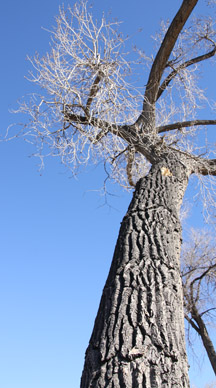
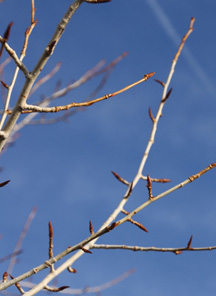
Left: Cottonwood: Brown, deeply furrowed bark of mature tree.
Above: Cottonwood - long, pointy buds
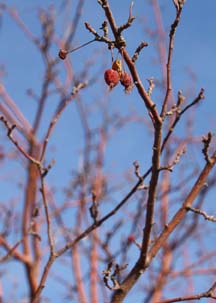
Crabapple: Reddish stems and buds (these aren't hairy). Small apples still cling to stem.
Dogwood – Red Osier (shrubs in Alamosa)
- -Clove-shaped flower bud
- -Leaf scar encircles the twig
- -Opposite branching
- -Redish stems
- -White pith
- -Mature bark is spotted looking – raised lenticel humps that look whitish
Elm (Ulmus spp.)
- -Zigzag twigs
- -Alternate branching
- -Bark acts like cork when pressed with finger nail (bounces back).
- -On Siberian flower buds are nearly spherical.
- -On Siberian leaf buds are small, round and very dark.
- -Buds are off center over the leaf scar.
Hackberry (celtis occidentalis) –member of Elm family
- -Alternate branching
- -Lumpy, warty bark some say look like mountain ranges
- -Extremely twiggy silhouette, especially in mature trees
- -Buds are small, somewhat flattened
- -No terminal bud
- -Older trees often have “witches broom”, twiggy outgrowths clusters (I haven’t seen in Alamosa)
- -Produce small berries (I haven’t seen in Alamosa)
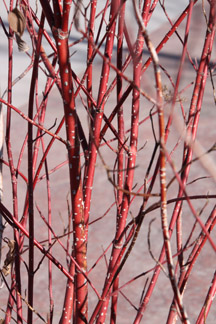
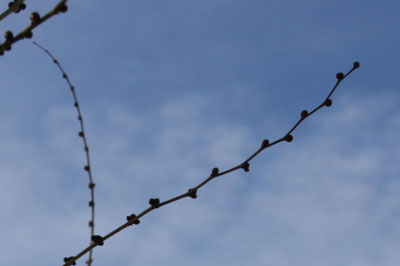
Left: Red-osier Dogwood (shrub in Alamosa) -- shows white, raised lenticels on red stems.
Middle: Siberian Elm -- zigzag twig pattern and dark, almost sperical lateral buds
Right: Hackberry -- note dense twigging structure near main trunk.
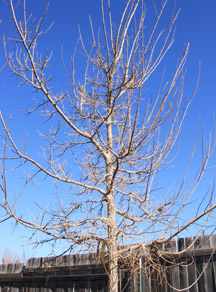
Honeylocust (gleditsia triacanthos)
- -Lateral buds often barely visible
- -Zigzag twig pattern
- -Seed pods spiral – may still be attached.
- -Natural-growing Honey Locust is extremely thorny, with long dagger-like thorns – often branching thorns
- -There are thorn-less varieties that are commonly planted in cities.
- -Young trunks have white oblong lenticels
- -Bark is usually unique, being somewhat slatey-gray and peeling to one side on mature trees.
Kentucky Coffee ( )
- -Looks dead in winter due to tiny buds, thick twigs and sparse branching.
- -Large leaf scars often almost heart-shaped
- -Absence of a prominent terminal bud
- -Lateral bud: bud placement off from leaf scars
- -Leaf scars are alternate and very large
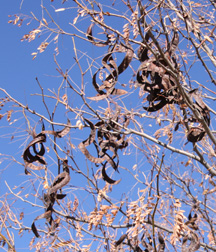
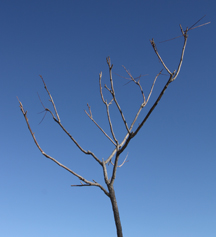
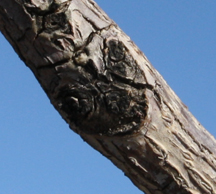
Left: Honeylocust -- distinctive spiral seed pods
Center: Kentucky Coffee in its dead-looking winter mode.
Right: Kentucky Coffee -- tilt your head left to see heart-shaped leaf scar.
Maple ( )
- -Opposite bud structure
- -Red buds and new red stems on red maple
- -Red maples often have clumped flower buds
- -Crescent shaped leaf scar
- -Terminal bud is egg-shaped and slightly larger than lateral buds
Maple, Amur ( ) --usually shrub-like in Alamosa
- -Opposite branching
- -Often retains seed pods
- -Small buds
- Leaf scars ledge-like
- Terminal buds occasionally paired
- Usually grown as shrub
Oak (Quercus spp.)
- -Alternate branching
- -Sometimes have clustered bud ends
- -Often retains leaves until late winter
- -Acorns persistent on twigs or dropped under tree
- -Slightly raised, semi-circular leaf scar
- -Bark varies a lot, so not very helpful indicator
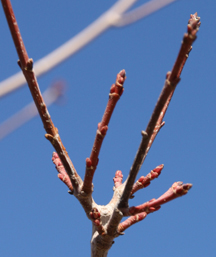
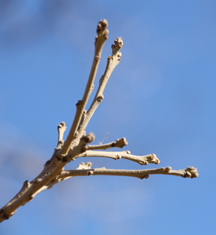
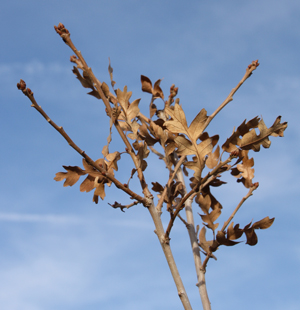
Left: Red Maple(Autumn Blaze)-- note red buds and oppostie branching
Middle: Bur Oak - note cluster of terminal buds -- hard to see opposite branching
Right: Bur Oak -- retained winter leaf
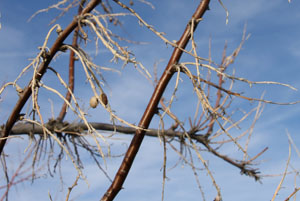
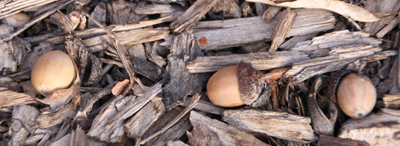
Left: Russian Olive: retained olives Above: Gambel's Oak (shrub) acorns on ground -- haven't seen any on young Bur Oaks around town
Russian Olive ( )
- -Alternate branching
- -Thorns
- -Twigs often grey looking
- -Redish stems
Willow ( )
- -Alternate branching
- -Most have yellow or orange twigs